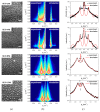Chemical Solution Deposition of Ordered 2D Arrays of Room-Temperature Ferrimagnetic Cobalt Ferrite Nanodots
- PMID: 31574914
- PMCID: PMC6835257
- DOI: 10.3390/polym11101598
Chemical Solution Deposition of Ordered 2D Arrays of Room-Temperature Ferrimagnetic Cobalt Ferrite Nanodots
Abstract
Over the past decades, the development of nano-scale electronic devices and high-density memory storage media has raised the demand for low-cost fabrication methods of two-dimensional (2D) arrays of magnetic nanostructures. Here, we present a chemical solution deposition methodology to produce 2D arrays of cobalt ferrite (CFO) nanodots on Si substrates. Using thin films of four different self-assembled block copolymers as templates, ordered arrays of nanodots with four different characteristic dimensions were fabricated. The dot sizes and their long-range arrangement were studied with scanning electron microscopy (SEM) and grazing incident small-angle X-ray scattering (GISAXS). The structural evolution during UV/ozone treatment and the following thermal annealing was investigated through monitoring the atomic arrangement with X-ray absorption fine structure spectroscopy (EXAFS) and checking the morphology at each preparation step. The preparation method presented here obtains array types that exhibit thicknesses less than 10 nm and blocking temperatures above room temperature (e.g., 312 K for 20 nm diameter dots). Control over the average dot size allows observing an increase of the blocking temperature with increasing dot diameter. The nanodots present promising properties for room temperature data storage, especially if a better control over their size distribution will be achieved in the future.
Keywords: 2D arrays; block copolymer; chemical solution deposition; cobalt ferrite; ferrimagnetic; nanodot.
Conflict of interest statement
The authors declare no conflicts of interest.
Figures









Similar articles
-
Morphology and magnetic properties of Fe3O 4 nanodot arrays using template-assisted epitaxial growth.Nanoscale Res Lett. 2015 Dec;10(1):2419. doi: 10.1186/1556-276X-10-4. Epub 2015 Jan 6. Nanoscale Res Lett. 2015. PMID: 26055471 Free PMC article.
-
Magnetization switching in high-density magnetic nanodots by a fine-tune sputtering process on a large-area diblock copolymer mask.Nanoscale. 2017 Nov 9;9(43):16981-16992. doi: 10.1039/c7nr04295g. Nanoscale. 2017. PMID: 29077107
-
Large-area Co-silicide nanodot arrays produced by colloidal nanosphere lithography and thermal annealing.Ultramicroscopy. 2008 Sep;108(10):1200-4. doi: 10.1016/j.ultramic.2008.04.065. Epub 2008 May 15. Ultramicroscopy. 2008. PMID: 18571855
-
Fabrication of magnetic nanodot arrays for patterned magnetic recording media.J Nanosci Nanotechnol. 2007 Jan;7(1):225-31. J Nanosci Nanotechnol. 2007. PMID: 17455486 Review.
-
Scratch on Polymer Materials Using AFM Tip-Based Approach: A Review.Polymers (Basel). 2019 Sep 29;11(10):1590. doi: 10.3390/polym11101590. Polymers (Basel). 2019. PMID: 31569474 Free PMC article. Review.
Cited by
-
Self-Assembly of Block Copolymers.Polymers (Basel). 2020 Apr 2;12(4):794. doi: 10.3390/polym12040794. Polymers (Basel). 2020. PMID: 32252360 Free PMC article.
-
Block Copolymer-Templated, Single-Step Synthesis of Transition Metal Oxide Nanostructures for Sensing Applications.ACS Appl Mater Interfaces. 2023 Dec 20;15(50):57970-57980. doi: 10.1021/acsami.3c10439. Epub 2023 Aug 29. ACS Appl Mater Interfaces. 2023. PMID: 37644616 Free PMC article. Review.
-
In-situ construction of Zr-based metal-organic framework core-shell heterostructure for photocatalytic degradation of organic pollutants.Front Chem. 2023 Jan 4;10:1102920. doi: 10.3389/fchem.2022.1102920. eCollection 2022. Front Chem. 2023. PMID: 36688034 Free PMC article.
References
-
- Singamaneni S., Bliznyuk V.N., Binek C., Tsymbal E.Y. Magnetic nanoparticles: Recent advances in synthesis, self-assembly and applications. J. Mater. Chem. 2011;21:16819–16845. doi: 10.1039/c1jm11845e. - DOI
-
- Guo S., Xu F., Wang B., Wang N., Yang H., Dhanapal P., Xue F., Wang J., Li R.-W. 2D Magnetic Mesocrystals for Bit Patterned Media. Adv. Mater. Interfaces. 2018;5:1800997. doi: 10.1002/admi.201800997. - DOI
-
- Ross C.A. Patterned Magnetic Recording Media. Annu. Rev. Mater. Res. 2001;31:203–235. doi: 10.1146/annurev.matsci.31.1.203. - DOI
-
- Liu F., Ross C.A. Size-dependent magnetic properties of 100–500 nm diameter IrMn/NiFe disks made by a two-step deposition process. J. Appl. Phys. 2014;116:194307. doi: 10.1063/1.4902080. - DOI
Grants and funding
LinkOut - more resources
Full Text Sources
Miscellaneous

